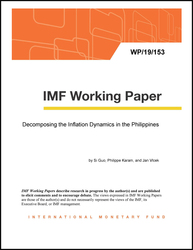
Decomposing the Inflation Dynamics in the Philippines
Inflation rates rose sharply in the Philippines during 2018. Understanding the demand and supply sources of inflation pressures is key to monetary policy response. Qualitatively, indicators have pointed to evidence of inflation pressures from both sides in 2018, with the supply factors, by and large, associated with commodity-price shocks and demand factors deduced from gleaning at the wider non-oil trade deficits seen in the Philippines. Quantitatively, we deploy a semi-structural model to decompose the contributions of various shocks to inflation. Our main findings are (1) supply factors (mainly global commodity prices) played a prominent role in explaining the rise in inflation in 2018; (2) demand factors also contributed to inflation in a non-negligible way, justifying the need for tighter monetary policy in 2018; (3) the size of the estimated output gap (an important indicator of demand pressures) could be larger, when considering the widening trade deficits in 2018; and (4) a delayed monetary policy tightening can be costly in terms of higher inflation rates, requiring larger and more aggressive interest rate hikes to bring inflation under control, based on a counterfactual exercise.
Publication date: July 2019
ISBN: 9781498319324
$18.00
Add to Cart by clicking price of the language and format you'd like to purchase
Available Languages and Formats
| English |
Prices in red indicate formats that are not yet available but are forthcoming.
Topics covered in this book
This title contains information about the following subjects.
Click on a subject if you would like to see other titles with the same subjects.
inflation , the Philippines , output gap , BSP , inflation rate , inflation target , policy stance
Summary
Copyright © 2010 - 2025
Powered by:
AIDC



